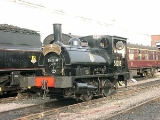
L&YR Class 21
Encyclopedia
The L&YR Class 21 is a class of small 0-4-0
ST steam locomotive
built by the Lancashire and Yorkshire Railway
for shunting duties. They were nicknamed Pugs.
 The London, Midland and Scottish Railway
The London, Midland and Scottish Railway
(LMS) gave the locomotives the power classification 0F. In total fifty seven were made between 1891 and 1910. They were built for use in sharply curved sidings for shunting duties. The Pugs were allocated by the L&YR for operation in the industrial areas and docks of Fleetwood, Goole, Liverpool and Salford. In later times they became more widely dispersed, reaching places such as Bristol, Bangor, Crewe, Derby, Widnes, York and Swansea. When the LMS was merged into British Railways on 1 January 1948, 23 'Pugs' remained in service. The last was withdrawn in 1964.
51218 first entered preservation in 1965 and is awaiting an overhaul on the Keighley and Worth Valley Railway
. When it does work because of its low power is not regularly used on passenger trains but makes appearances at galas and charters. It last steamed in 2005. No. 19 came into preservation in 1967 and was sold by the LMS in 1931 into industrial use, but is unlikely to be steamed again in the foreseeable future. It is on display at the Ribble Steam Railway
.
then passed on to Dapol
, which still manufactures the former Airfix plastic kit range. A ready-to-run OO model was produced initially by Airfix then Dapol and finally Hornby
where the Pug was produced until 2000. The Pug was reintroduced to Hornby's range in 2010 (R2927) in early British Railways Livery.
0-4-0
Under the Whyte notation for the classification of steam locomotives, 0-4-0 represents one of the simplest possible types, that with two axles and four coupled wheels, all of which are driven...
ST steam locomotive
Steam locomotive
A steam locomotive is a railway locomotive that produces its power through a steam engine. These locomotives are fueled by burning some combustible material, usually coal, wood or oil, to produce steam in a boiler, which drives the steam engine...
built by the Lancashire and Yorkshire Railway
Lancashire and Yorkshire Railway
The Lancashire and Yorkshire Railway was a major British railway company before the 1923 Grouping. It was incorporated in 1847 from an amalgamation of several existing railways...
for shunting duties. They were nicknamed Pugs.
Operational history

London, Midland and Scottish Railway
The London Midland and Scottish Railway was a British railway company. It was formed on 1 January 1923 under the Railways Act of 1921, which required the grouping of over 120 separate railway companies into just four...
(LMS) gave the locomotives the power classification 0F. In total fifty seven were made between 1891 and 1910. They were built for use in sharply curved sidings for shunting duties. The Pugs were allocated by the L&YR for operation in the industrial areas and docks of Fleetwood, Goole, Liverpool and Salford. In later times they became more widely dispersed, reaching places such as Bristol, Bangor, Crewe, Derby, Widnes, York and Swansea. When the LMS was merged into British Railways on 1 January 1948, 23 'Pugs' remained in service. The last was withdrawn in 1964.
Preservation
Two have survived to preservation, these are L&YR 68 (later LMS 11218 and BR 51218) and 1910-built L&YR 19 (LMS 11243). Both "Pugs" are now owned by The Lancashire and Yorkshire Railway Trust, a Registered Charity, reg no 1002627.51218 first entered preservation in 1965 and is awaiting an overhaul on the Keighley and Worth Valley Railway
Keighley and Worth Valley Railway
The Keighley and Worth Valley Railway is a long branch line that served mills and villages in the Worth Valley and is now a heritage railway line in West Yorkshire, England. It runs from Keighley to Oxenhope. It connects to the national rail network line at Keighley railway station...
. When it does work because of its low power is not regularly used on passenger trains but makes appearances at galas and charters. It last steamed in 2005. No. 19 came into preservation in 1967 and was sold by the LMS in 1931 into industrial use, but is unlikely to be steamed again in the foreseeable future. It is on display at the Ribble Steam Railway
Ribble Steam Railway
The Ribble Steam Railway is a standard gauge preserved railway in Lancashire, in the United Kingdom. It was opened to the public on 17 September 2005, running along Preston Docks,...
.
Models
Several models of the 'Pug' have been produced commercially. The first was a 'OO'-scale polystyrene kit made in the 1960s by Kitmaster, the moulds for which were subsequently sold to AirfixAirfix
Airfix is a UK manufacturer of plastic scale model kits of aircraft and other subjects. In Britain, the name Airfix is synonymous with the hobby, a plastic model of this type is often simply referred to as "an airfix kit" even if made by another manufacturer....
then passed on to Dapol
Dapol
Dapol Ltd is a Welsh model railway manufacturer based in Chirk, Wales. The factory where design and manufacturing take place is just over the border in England.The Dapol trading name is known for its model railway products in N and OO gauges.-History:...
, which still manufactures the former Airfix plastic kit range. A ready-to-run OO model was produced initially by Airfix then Dapol and finally Hornby
Hornby Railways
Hornby Railways is the leading brand of model railway in the United Kingdom. Its roots date back to 1901, when founder Frank Hornby received a patent for his Meccano construction toy. The first clockwork train was produced in 1920. In 1938, Hornby launched its first 00 gauge train...
where the Pug was produced until 2000. The Pug was reintroduced to Hornby's range in 2010 (R2927) in early British Railways Livery.

